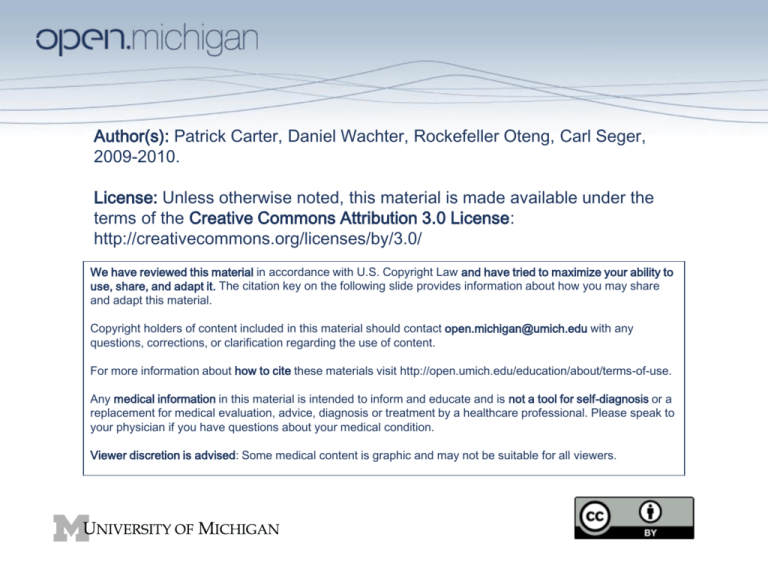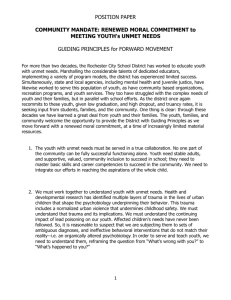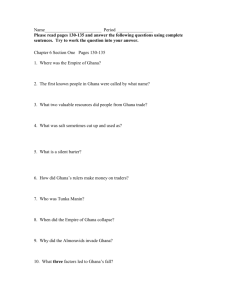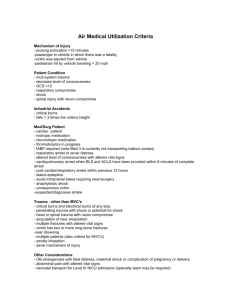Advanced Emergency Trauma Course
advertisement

Author(s): Patrick Carter, Daniel Wachter, Rockefeller Oteng, Carl Seger,
2009-2010.
License: Unless otherwise noted, this material is made available under the
terms of the Creative Commons Attribution 3.0 License:
http://creativecommons.org/licenses/by/3.0/
We have reviewed this material in accordance with U.S. Copyright Law and have tried to maximize your ability to
use, share, and adapt it. The citation key on the following slide provides information about how you may share
and adapt this material.
Copyright holders of content included in this material should contact open.michigan@umich.edu with any
questions, corrections, or clarification regarding the use of content.
For more information about how to cite these materials visit http://open.umich.edu/education/about/terms-of-use.
Any medical information in this material is intended to inform and educate and is not a tool for self-diagnosis or a
replacement for medical evaluation, advice, diagnosis or treatment by a healthcare professional. Please speak to
your physician if you have questions about your medical condition.
Viewer discretion is advised: Some medical content is graphic and may not be suitable for all viewers.
Citation Key
for more information see: http://open.umich.edu/wiki/CitationPolicy
Use + Share + Adapt
{ Content the copyright holder, author, or law permits you to use, share and adapt. }
Public Domain – Government: Works that are produced by the U.S. Government. (USC 17 § 105)
Public Domain – Expired: Works that are no longer protected due to an expired copyright term.
Public Domain – Self Dedicated: Works that a copyright holder has dedicated to the public domain.
Creative Commons – Zero Waiver
Creative Commons – Attribution License
Creative Commons – Attribution Share Alike License
Creative Commons – Attribution Noncommercial License
Creative Commons – Attribution Noncommercial Share Alike License
GNU – Free Documentation License
Make Your Own Assessment
{ Content Open.Michigan believes can be used, shared, and adapted because it is ineligible for copyright. }
Public Domain – Ineligible: Works that are ineligible for copyright protection in the U.S. (USC 17 § 102(b)) *laws in
your jurisdiction may differ
{ Content Open.Michigan has used under a Fair Use determination. }
Fair Use: Use of works that is determined to be Fair consistent with the U.S. Copyright Act. (USC 17 § 107) *laws in your
jurisdiction may differ
Our determination DOES NOT mean that all uses of this 3rd-party content are Fair Uses and we DO NOT guarantee that
your use of the content is Fair.
To use this content you should do your own independent analysis to determine whether or not your use will be Fair.
Advanced Emergency
Trauma Course
Shock
Presenter: Carl Seger, MD
Ghana Emergency Medicine Collaborative
Patrick Carter, MD ∙ Daniel Wachter, MD ∙ Rockefeller Oteng, MD ∙ Carl Seger, MD
Overview
Introduction
• Definition
• Physiology
Initial Patient Assessment
• Recognize
Types of Shock
Classes of Hemorrhagic Shock
Treating Hemorrhagic Shock
• Fluid/Blood Resuscitation
• Evaluating treatment of Shock
Ghana Emergency Medicine Collaborative
Advanced Emergency Trauma Course
Introduction
In order to treat shock appropriately, it
must first be recognized, then identify the
cause
In order to recognize it, it is important to
understand some of the physiology of the
disease process
Ghana Emergency Medicine Collaborative
Advanced Emergency Trauma Course
Definition
A physiological state that results in
inadequate organ perfusion and tissue
oxygenation
Downward spiral of impaired perfusion
leading to impaired function
Results in multiple organ failure and death
Ghana Emergency Medicine Collaborative
Advanced Emergency Trauma Course
Basic Physiology
Oxygen Delivery = CO x arterial content of O2
Cardiac Output = HR x Stroke Volume
Stroke Volume is a function
• Preload
• Afterload
• Myocardial Contractility
Ghana Emergency Medicine Collaborative
Advanced Emergency Trauma Course
Pathophysiology
Blood loss
• Release of endogenous catecholamines
Increase cardiac output
• Increase heart rate
• Vasoconstriction of less vital organs
skin, muscle
Results in higher diastolic BP (narrow PP)
Continue to perfuse vital organs as long as
possible (brain, heart, kidney)
Ghana Emergency Medicine Collaborative
Advanced Emergency Trauma Course
Initial Patient Assessment
Recognition of Shock
• Clinical signs and symptoms depends
on the severity of the shock
• Early manifestations include tachycardia
and cutaneous vasoconstriction
Ghana Emergency Medicine Collaborative
Advanced Emergency Trauma Course
Clinical Pathophysiology of
Shock
General / Vital signs
Cardiovascular- tachycardia
Skin- vasoconstriction vs. vasodilation
Respiratory- increased RR
Urinary- decrease urine output
Neurologic- confusion, agitation
Extremities- cold vs. warm
Ghana Emergency Medicine Collaborative
Advanced Emergency Trauma Course
Clinical Endpoints of Shock
DECREASED BLOOD FLOW TO BRAIN AND HEART
Restless, agitated, confused, lethargy
Hypotension
Tachycardia
Tachypnea
END-STAGE SHOCK
Bradycardia
Arrythmias
Death
Ghana Emergency Medicine Collaborative
Advanced Emergency Trauma Course
Classifying Shock
Hypovolemic
• Hemorrhagic
Distributive /Vasogenic
• Sepsis, Anaphylactic
Cardiogenic
Neurogenic
• Spinal cord injury
Ghana Emergency Medicine Collaborative
Advanced Emergency Trauma Course
SIRS
Systemic Inflammatory Response Syndrome -SIRS
• Defined by the presence of two or more of the
following:
Body temp < 36 °C (97 °F) or > 38 °C (100 °F)
Heart Rate > 90 bpm
RR > 20 bpm
WBC < 4,000 cells/mm3 or > 12,000 cells/mm3 (<
4 × 109 or > 12 × 109 cells/L), or greater than 10%
band
Ghana Emergency Medicine Collaborative
Advanced Emergency Trauma Course
Sepsis and Septic Shock
Sepsis- Defined as SIRS in response to a
confirmed infectious process.
Septic shock- Defined as sepsis with
refractory arterial hypotension or
hypoperfusion abnormalities in spite of
adequate fluid resuscitation.
Ghana
Emergency
Medicine
Collaborative
Ghana
Emergency
Medicine
Collaborative
Advanced
Emergency
Trauma
Course
Advanced
Emergency
Trauma
Course
Septic Shock
A blood borne infection
widely disseminated to
many areas of the body
Common features are
high fever, vasodilatation
(especially in affected
tissues)
Sludging of the blood,
and RBC agglutination
resulting in DIC
http://en.wikipedia.org/wiki/File:Staphylo
coccus_aureus_Gram.jpg
Ghana Emergency Medicine Collaborative
Advanced Emergency Trauma Course
Anaphylactic Shock
An IgE mediated event that triggers massive release of immune
response mediators
Results in widespread peripheral vasodilation, bronchial smooth
muscle contraction, and local vascular dilatation
Justin Beck (flickr)
Ghana Emergency Medicine Collaborative
Advanced Emergency Trauma Course
Cardiogenic Shock
Key elements are hypotension (SBP < 90) and
hypoperfusion with pulmonary congestion
Mortality is 50 - 80% before reperfusion therapy
Acute myocardial ischemia is most common cause
Ghana Emergency Medicine Collaborative
Advanced Emergency Trauma Course
Patrick J. Lynch, medical
illustrator;
C. Carl Jaffe, MD, cardiologist
(Wikipedia)
Neurogenic Shock
Result of spinal cord injury
Loss of sympathetic tone
Decreased vasomotor tone
Results in hypotension and
bradycardia
Patients may remain alert,
warm, and dry despite the
hypotension
Photo of Christopher Reeve taken by
gunkyboy (Wikipedia)
Ghana Emergency Medicine Collaborative
Advanced Emergency Trauma Course
Case 1
29 y/o male, PVA while crossing the street,
awake, complaining of severe back pain, and
inability to move or feel his legs
HR 45 RR 25 BP 100/45 Sa02 98% T34.0
Ghana Emergency Medicine Collaborative
Advanced Emergency Trauma Course
What do we do next?
Maintain ventilation
Enhance perfusion
Treat underlying cause
Ghana Emergency Medicine Collaborative
Advanced Emergency Trauma Course
What studies or labs can help
you immediately?
X-rays
FAST exam
Frequent vital
signs
Continuous
cardiac and
oxygen monitoring
http://en.wikipedia.org/wiki/File:Morrisons-withfluid.jpg
Ghana Emergency Medicine Collaborative
Advanced Emergency Trauma Course
X-rays from the trauma bay
Source Undetermined
Source Undetermined
Ghana Emergency Medicine Collaborative
Advanced Emergency Trauma Course
Neurogenic Resuscitation
Adequate oxygenation
Assess breathing
Maximize circulation
• IV fluids or blood
• Pressors if necessary
Support heart rate if needed
• Atropine
Prepare for the OR
Ghana Emergency Medicine Collaborative
Advanced Emergency Trauma Course
Hypovolemic
Hemorrhagic
• Mostly traumatic
• Focus of today
Severe burn
GI losses
• vomiting and diarrhea
Urinary
• DKA
Ghana Emergency Medicine Collaborative
Advanced Emergency Trauma Course
Classes of Hypovolemic Shock
CLASS
I
II
III
IV
BVL
< 15%
15 - 30%
30 - 40%
> 40%
AMOUNT
750 cc
750 - 1500 cc
1500 - 2000 cc
> 2000 cc
PULSE
<100
> 100
>120
>140
BP
No change
Narrowed pulse
pressure
Consistent decrease
in SBP
Decreased SBP and
narrowed pulse pressure or
no DBP
RESP
No change
20-30
30-40
>35
CNS
No change
Anxiety
Anxious, confused
Confused. lethargic
Urine
>30cc per hr
20-30cc per hr
5-15cc per hr
negligible
TX
Replace fluid
loss
2L NS IV
2 L NS IV, usually requires
blood transfusion
Rapid transfusion of blood
and NS, requires immediate
intervention to stop
hemorrhage
Ghana Emergency Medicine Collaborative
Advanced Emergency Trauma Course
Treating Hemorrhagic Shock
As always ABC’s
• Airway and Breathing
Would prefer O2 sat greater than 95%
Placing O2 on the patient
• Circulation
Hemorrhage Control
Vascular Access, Large bore IV x 2
Ghana Emergency Medicine Collaborative
Advanced Emergency Trauma Course
Monitoring
Continuous monitoring
Oxygen Saturation
Urine output
Source Undetermined
Ghana Emergency Medicine Collaborative
Advanced Emergency Trauma Course
LR Hopson, 2005
Treating Hemorrhagic Shock
Identify & reverse the cause
Restore tissue perfusion
Restore organ function
Ghana Emergency Medicine Collaborative
Advanced Emergency Trauma Course
Initial Fluid Therapy
Adult with normal Cardiac Function
• 1 to 2 Liters of LR or NS rapidly
Pediatric
• 20ml/kg of LR or NS rapidly
Evaluate patients response to fluid
Ghana Emergency Medicine Collaborative
Advanced Emergency Trauma Course
Evaluation of Treatment
Assess organ perfusion
• Urinary output
• Mental Status
• Skin exam
• Vitals
Ghana Emergency Medicine Collaborative
Advanced Emergency Trauma Course
Response to Initial Fluid
Rapid Response
Transient
Response
No Response
Vitals
Return to normal
Transient
improvement with
return to previous
Remain Abnormal
Estimated Blood
loss
10-20%
20-40% with
ongoing likely
Severe >40%
Need for more
Fluid
Low
High
High
Need for Blood
Type and cross
Type specific
O neg
Need for surgery
Possible
Likely
Highly likely
Ghana Emergency Medicine Collaborative
Advanced Emergency Trauma Course
Case 2
25 year old male in a head on motor
vehicle accident. He has sustained
obvious chest and abdominal trauma and
has a GCS of 13.
VS: HR 125 RR 28 BP 100/50 T 36.0
Sa02 93% on 100%
Patient is agitated and confused.
Ghana Emergency Medicine Collaborative
Advanced Emergency Trauma Course
What class of Shock?
Class III
ABC
IV Access
2 liters of NS
Ghana Emergency Medicine Collaborative
Advanced Emergency Trauma Course
Case #2 cont
Patients Vitals after 2 liters:
• HR 95 RR 25 BP 110/70
Ghana Emergency Medicine Collaborative
Advanced Emergency Trauma Course
Case #3
17 y/o male cuts his inner thigh with a
sickle
•
•
•
•
Presents hemorrhaging from left groin area
Awake and Alert
VS: BP 120/60 HR 120 RR 30 Sat 98% on RA
Pt has pulse distally in Lt Leg
Ghana Emergency Medicine Collaborative
Advanced Emergency Trauma Course
What to do?
ABC
• Direct Pressure to bleeding area
• IV Access
• 2 Liters NS
Ghana Emergency Medicine Collaborative
Advanced Emergency Trauma Course
Case #3
After 2 Liters
• Having difficulty controlling bleeding
• Vital Signs
HR 130 BP 85/60 RR 30 Sat 100% on NC
Ghana Emergency Medicine Collaborative
Advanced Emergency Trauma Course
Case #3
What Next?
• More Fluid
• Blood
• Surgeon?
Ghana Emergency Medicine Collaborative
Advanced Emergency Trauma Course
Which Pressor should I choose?
Hypovolemic shock
• Neosynephrine - alpha agonist
• Fluids and Blood
Cardiogenic shock
• Dobutamine - 1 agonist
Neurogenic shock
Anaphylactic shock
• Fluids and epinephrine
Increases SVR by
arteriolar constriction
• Norepinephrine/Levophed - alpha
and beta agonists
Increases squeeze and
heart rate
• Fluids, phenylephrine, Levophed,
look for another type of shock if
it is persistent
Septic shock
Dopamine
• Low Dose - increases renal blood
supply
• Medium Dose - beta effects
(increases heart rate and squeeze)
• High Dose - alpha effects
(arteriolar constriction)
Ghana Emergency Medicine Collaborative
Advanced Emergency Trauma Course
Overview
Introduction
• Definition
• Basic Physiology
Initial Patient Assessment
• Recognize
Types of Shock
Classes of Hemorrhagic Shock
Treating Hemorrhagic Shock
• Fluid/Blood Resuscitation
• Evaluating treatment of Shock
Ghana Emergency Medicine Collaborative
Advanced Emergency Trauma Course
Questions?
Dkscully (flickr)
Ghana Emergency Medicine Collaborative
Advanced Emergency Trauma Course
References
Rivers, E., Otero, R., Nguyen, H. Approach to the patient in shock, in Emergency Medicine: A
Comprehensive Guide. Tintinalli, Editor. 2004, McGraw-Hill. p. 219-225.
Manning, J.Fluid and Blood Resuscitation, in Emergency Medicine: A Comprehensive Guide.
Tintinalli, Editor. 2004, McGraw-Hill. p. 225-231.
Jui, J. Septic Shock, in Emergency Medicine: A Comprehensive Guide. Tintinalli, Editor. 2004,
McGraw-Hill. p. 231-242.
Peacock, W., Weber, J. Cardiogenic Shock, in Emergency Medicine: A Comprehensive Guide.
Tintinalli, Editor. 2004, McGraw-Hill. p. 242-247.
Rowe, B., Carr, S., Anaphylaxis and Acute Allergic Reactions, in Emergency Medicine: A
Comprehensive Guide. Tintinalli, Editor. 2004, McGraw-Hill. p. 242-252.
Euerle, B., Scalea, T. Neurogenic Shock, in Emergency Medicine: A Comprehensive Guide.
Tintinalli, Editor. 2004, McGraw-Hill. p. 219-255.
American College of Surgeons. Shock, in Advanced Trauma Life Support for Doctors 7th edition.
2004. p. 62-102.
Mills, T. Trauma Resuscitation, in Emergency Medicine. Adams, Editor. 2008, Saunders Elsevier.
p. 77-84
Ghana Emergency Medicine Collaborative
Advanced Emergency Trauma Course






